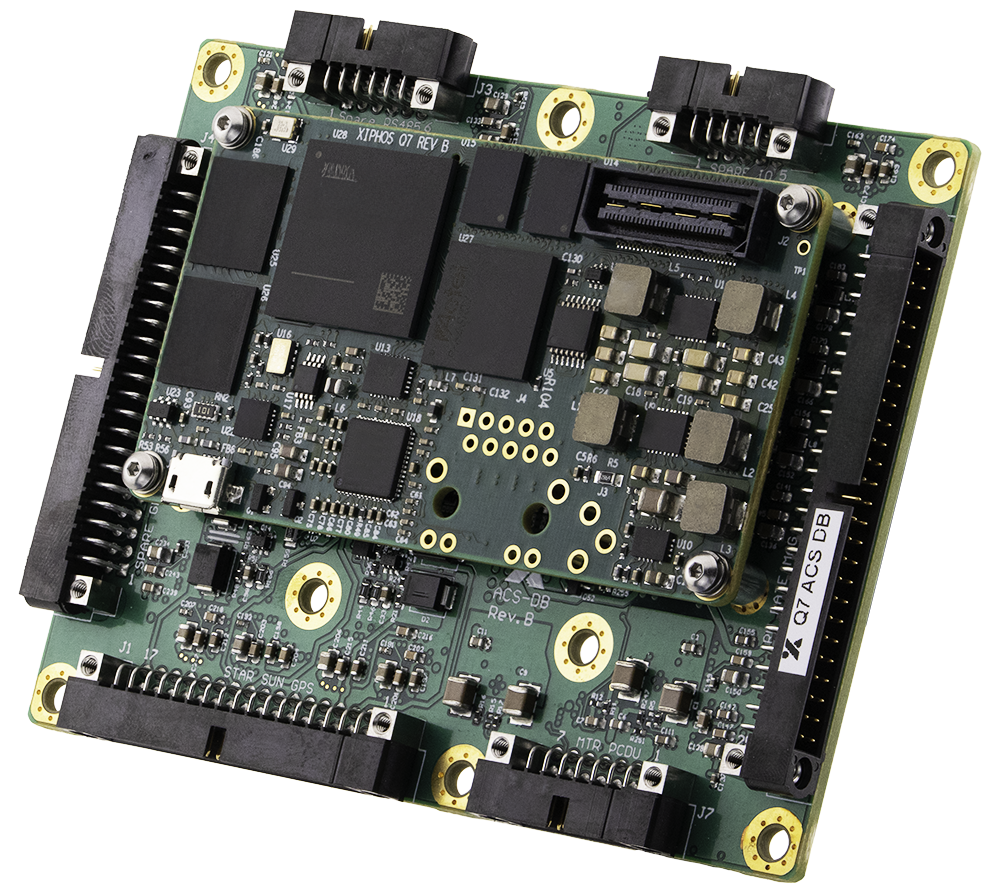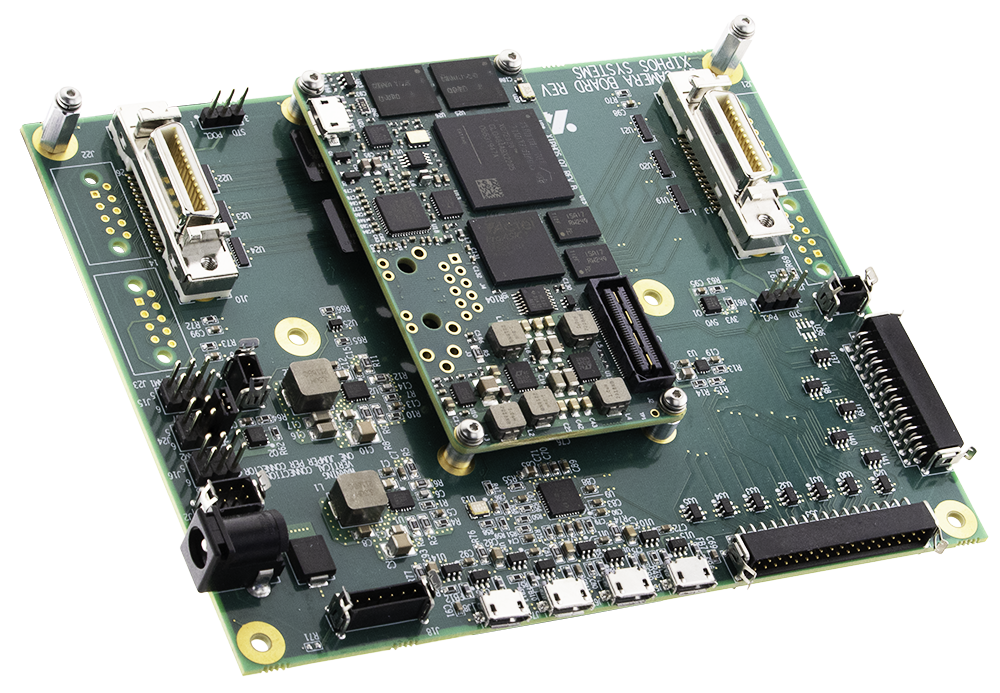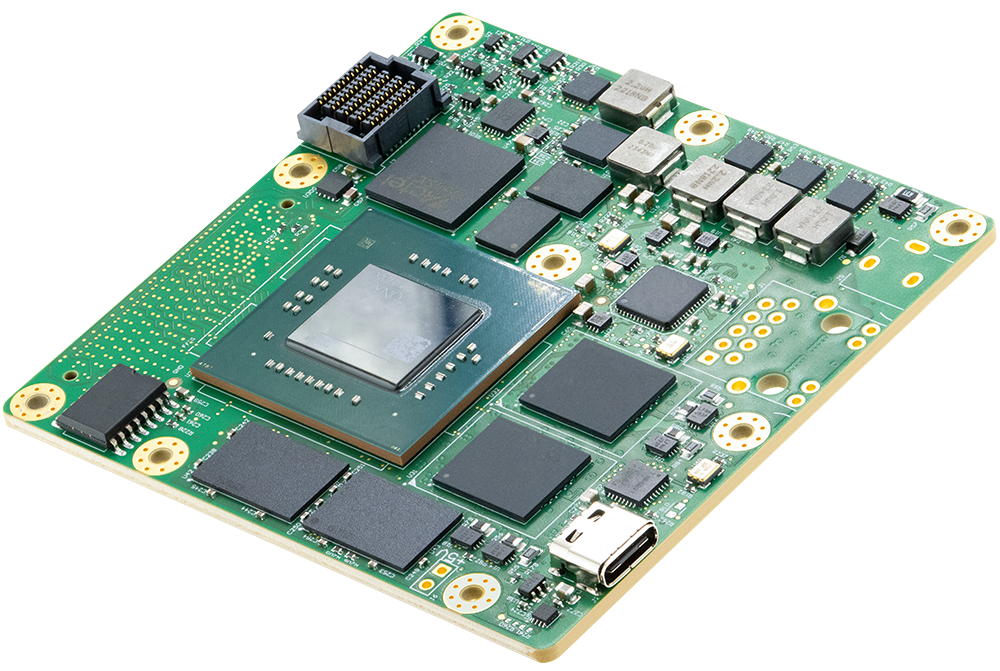Absolutely. Xiphos has a rich history in creating Processor Boards designed explicitly for space applications using COTS components. Every element, from component selection to logic features, is designed to exceed your mission expectations. We've proven our capabilities in various missions and roles.
Q7 ACS DaughterBoard
The Q7 Attitude Control System (ACS) daughterboard is a daughterboard for the Q7 processor card that provides a suite of functions and interfaces that are commonly required in a satellite ACS subsystem. Given the large suite of interfaces and functions available on the board, it can also be used in more general applications, where only a subset of the available functions are required.

The Q7 ACS Daughterboard offers the following key features:
Interfaces:
- Numerous RS-422 and RS-485 serial interfaces, multiple GPIO
Additional Functions:
- Multiple switchable 5V, 15V, and 28V outputs, 3x full H-Bridge drivers, current and voltage monitoring & telemetry
Size:
- 100 x 76 x 14.5 mm (with Q7, excluding RJ45 connector)
Input Voltage:
- 25 to 34V (28V nominal)
Power consumption:
- 2.7W @ idle
Specific Use
The Q7 ACS daughterboard, in conjunction with the Q7, is generally used as an Attitude Control System computer or as a satellite platform’s Onboard Computer (OBC). Given the large suite of interfaces and functions available on the board, it can also be used for more general use, connecting to numerous other systems in a bus or payload for command and control applications.
Did you know
In addition to our standard daughterboards, we offer application-specific development integrating our powerful Q-Card processors with the interfacing options and application-specific electronics you require. Contact our team to learn more about customization.
Other products

Q7 Camera Board
The Q7 Camera Board is a development board allowing the rapid integration of high-performance image processing algorithms into your camera systems for high-bandwidth video or imagery applications. The Xiphos Q7 Camera Board is a Daughterboard for the Xiphos Q7 Processor Board. It supports typically-used space-based camera interfaces, allowing the Q7 to be quickly integrated with the desired cameras to begin software development.
- Interfaces: Multiple USB 2.0, GPIO, serial, SpaceWire*, Camera Link* (2x Base, or 1x Medium, or 1x Full)**, multiple camera power outputs
- Size: 110 x 110 x 15 mm
- Input Voltage: 15-28V
- Can be configured as LVDS. SpaceWire and Camera Link IP cores available from Xiphos.
- Interfaces cannot all be used concurrently. Details of configuration options are available by request.
- Power: Linux Software Development Kit (SDK)
- Rea Time Clock: Radiation effects mitigation & 25krad TID lifetime

Q8
We’re taking high-performance up a notch with the Q8, the latest addition to our spaceflight-ready miniature processing boards. Building upon the solid reputation of the Xiphos line, the Q8 maintains the same efficient design while setting new records in performance. It's like taking the known limits of processor power and giving them a caffeine boost.
- Builds on the extensive heritage of flight-proven Q-card family
- Xilinx Zynq UltraScale+ Multi-Processor System-on-Chip (MPSoC) Processing FPGA, including quad-core ARM Cortex-A53 Application Processing Unit, dual-core ARM Cortex-R5 Real-Time Processing Unit, and ARM Mali-400 GPU supported by massive programmable logic resources
- Memory: 4 GB of LPDDR4 RAM (with ECC), 2 x 256 MB QSPI Flash (NOR), and 2 x 128 GB eMMC.
- Power: typical 5W @ 5V to 16V
- Interfaces: Gigabit Ethernet, USB 2.0 & 3.1, serial, multiple high speed I/O via mezzanine connector, including GPIO, LVDS, and GTR multi-Gbps transceivers for SATA or PCI Express (PCIe Gen 2)
- Linux SDK
- Radiation effects mitigation & 30krad TID lifetime
FAQ
Are Xiphos products truly space-ready?
Where are Xiphos products typically deployed?
With the burgeoning New Space market, our products have found their place in numerous LEO applications, launchers, and even on the moon. We analyze your specific requirements and recommend the most suitable product to ensure mission success.
What tools are necessary to design my solution on Xiphos boards?
We provide a Linux Software Development Kit (SDK) based on industry-standard toolchains, enabling our customers to implement their designs on our boards rapidly. We also offer a Vivado skeleton project as a starting point, leaving over 90% of the FPGA resources available for your application.
Can Xiphos accommodate specific interface requirements for my mission?
Absolutely! We collaborate closely with our customers to cater to varied interface requirements. We either provide a ready solution or guide your team on how to implement it.
Does Xiphos offer technical support?
Yes, we do: Our technical support aims to assist with product understanding and overcoming initial learning curves. We also provide project-specific support packages, which can be utilized to develop custom software or logic, review your design, or even aid in designing your carrier board.
How does Xiphos quantify radiation exposure?
We quantify radiation exposure through testing of both Total Ionizing Dose (TID), which accumulates over time, and Single-Event Effects (SEE), which is more like a lightning strike. TID is a measure of the total amount of radiation that a device is expected to be exposed to over its mission life, while SEE is a measure of the effects of the individual "hits" of radiation that a device has experienced.
What is the architecture of the Xiphos COTS-based Processor Board that makes it useable Space?
The board has dual FPGA (processor and supervisor) and ECC for its memory banks. It also provides a suite of other radiation effects mitigation features. We also ensure that the selected components can survive the harsh radiation environment of space.
How does Xiphos handle the memory scrubbing of memory devices?
Xiphos provides memory scrubbing software that can be run in the background of the main application software to clear single-bit errors in memory.
What kind of design validation does Xiphos perform?
Xiphos conducts a radiation qualification test campaign, including board-level proton and TID (gamma ray) testing, as well as an environmental qualification that includes TVAC, vibration, and shock testing.
What documentation does Xiphos provide to customers?
We provide spec sheets, pinout files, user manuals, mechanical drawings, and 3D STEP files, some of which are provided under NDA.
Can you provide details about the different types of Xiphos Processor Boards?
The document lists various Processor Boards with their specifications, like the Q7, Q7AE, Q7RH, Q8, Q8J, Q8RF, and Q8RH.
What are the available Daughterboards for Q7 and Q8 processors?
For Q7, there's the Q7ACS and Q7 Camera Board. For Q8, there's the Q8 Camera Board, Q8 SDR Dock, and Q8 DHMMU.
What peripherals and interfaces are available in the Q7 Zynq 7020 MPSoC FPGA?
The Q7 MPSoC FPGA has multiple ‘hard core” peripherals, including 2x Gigabit Ethernet MAC, 2x USB 2.0, 2x CAN 2.0B, 2x SDIO, 2x SPI, 2x UART, 2x I2C, GPIO. For Q8, there's PCI Express 2.1, SATA 6Gbs rev 3.1, 4x Ethernet MAC rev 2.0, and 2x USB rev 2
What peripherals are available in the Q8 and Q8J Zynq UltraScale+ MPSoC FPGA?
The Q8 and Q8J MPSoC FPGAs have multiple ‘hard core” peripherals, including 4x Gigabit Ethernet MAC, 2x USB 3.0/2.0, 2x CAN 2.0B, 2x SDIO, 2x SPI, 2x UART, 2x I2C, GPIO, PCI Express (PCIe) Gen 2, and SATA 6Gbs Rev 3.1. The Q8J also provides access to the MPSOC’s 2x PCIe Gen 3 cores in the PL.
What are the main offerings of Xiphos?
Xiphos creates superior, high-performance, space-ready COTS-based Processor Boards and Daughterboards, leveraging the power of Xilinx MPSoC FPGAs.
What sort of advantages does Xiphos bring to the table?
Quite a lot!
- Exceptional performance: Our products are built to deliver unparalleled performance in the most challenging applications.
- Flight-proven resilience: Rigorous testing under the harshest conditions ensures the reliability of our products.
- Tailored solutions: We offer customization to cater to your specific needs.
- Comprehensive support: Our wide range of support options will ensure you get the maximum value out of our products.
What are the distinct product categories offered by Xiphos?
- Processor Boards: The beating heart of our product line, our Processor Boards come packed with various features and options to cater to diverse applications.
- Daughterboards: Our Daughterboards are compact and specialized, designed for particular applications such as SDR, imaging, or robotics.
- Software: We provide a suite of software tools to aid you in developing and deploying various applications on our products.
How can I procure products from Xiphos?
Xiphos' products can be accessed through multiple channels, including this website, authorized distributors, and direct sales representatives.
Contact Us
We would love to answer your questions. Be that about our products and solutions, joining our team, or where to get the best pizza in Montreal. Just drop in your details below!
Partner With Us
Ask us about our technology or discover what Xiphos can do for your organization. Just drop in your details below.